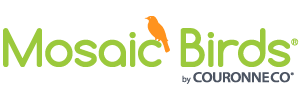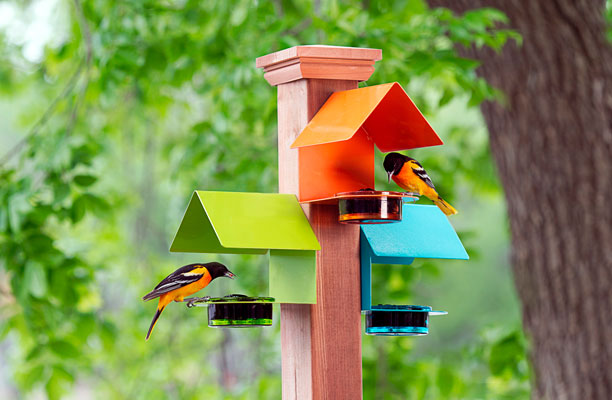12 ideas for where to place bird feeders, with both bird brains and beauty in mind
By Karuna Eberl, for Mosaic Birds, May 15, 2022 Mosaic
Let’s face it, our motivation for feeding birds is often a bit selfish. Watching them simply makes us happy. But birds are also an important part of our garden’s balanced ecosystem. So properly planning where to place feeders and baths is integral to making our yards more attractive to birds, while also more aesthetically pleasing to us humans.
“There’s no one best place to put feeders in a backyard,” says Holly Grant, of the Cornell Lab of Ornithology’s NestWatch. “Different species have different preferences for feeder foods and types. Some species prefer to forage on the ground, while others only eat certain kinds of food.”
Because of that, a variety of feeders and feeder placements is ideal for attracting a diversity of species. Here are some ideas, whether you just want a quick avian fix, or an all-out, stylish, backyard bird playground.
Enhance a Pollinator Garden
An elegant bird feeder or bird bath can add artistic flair to your pollinator garden. Make sure a lot of those gorgeous blooms are native plants, which promote biodiversity in your yard ecosystem.
Use Multiple Feeders
A variety of feeders, tucked into in different habitats, will attract a greater diversity of birds. “It also reduces competition and territoriality if any birds are bullying others,” says Grant.

Create a Plant Border
To enhance your feeder’s appeal, rim your garden with colorful, seeding plants and flowering native shrubs. This natural bird seed will help supplement your feeders and increase the number of species in your yard.
Hang a Hummingbird Feeder Near a Trellis
Flowering vines encourage hummingbirds to visit your feeder and give them some nutritional diversity. To install a trellis, find a sunny spot to plant climbing, tube-shaped flowering vines.

Landscape Below Feeders
If sunflower shells and other food debris under your feeder start looking like a mess, try adding a thick layer of mulch, a wildflower garden, or low-growing shrubs. If that’s too much work, go gravel. Start with a shallow circular base, such as a landscaping tree ring, and fill it with gravel to catch and disperse the mess.
Anchor a Lonely Corner
A splash of color from a feeder in the far corner can make an otherwise overlooked area come to life. Some birds also love a quiet place where they don’t feel threatened by too much human activity. Place feeders close to natural cover, such as trees or shrubs, which offer refuge as they wait their turn to feed. “Evergreens are ideal,” says Grant, “as they provide thick foliage that hides birds from predators and buffer winter winds.” Just don’t place feeders too close to strong branches, which are good jump-off points for squirrels and cats. “A distance of about 10 feet seems to be a good compromise,” she says.
Don’t Forget the Water
In some places, providing water is an equally good way to attract birds as feeders. Hang bird baths around the yard for birds to drink from and bathe in. It’s crucial for bird health to clean them regularly, along with your feeders.

Add Brush Piles
“You can provide resting and escape cover for ground-dwelling birds, such as song sparrows, by placing loosely stacked brush piles near your feeders,” says Grant. It might not look gorgeous to you, but leaf litter and brush piles are heavenly for birds and encourage a rich supply of insects and grubs to help nesting birds thrive.
Make Feeders Easy to Fill and Watch
Place your feeders in areas where they are easy to see and convenient to refill and clean. If they’re going near a window, break up reflections that birds perceive as pathways through windows with streamers, stickers, and crisscrossed branches in window frames. If strikes are still a problem, attach netting, like the kind you’d use to keep deer from eating your plants, to the outside of the window to buffer their impact. “We often suggest putting feeders within 3 feet of a window to help reduce strikes,” says Grant. “It’s too close for birds to gain enough momentum when flying off the feeder to do harm if they do fly into the glass.”
Follow the Shui
If you’ve set up your house according to Chinese feng shui principles, you can use bird feeders and bird baths to continue the positive energy flow into and around your yard. Use both the color of the feeder and its placement to anchor bagua areas and create harmony and balance.
Embrace A Little Disorder
A meticulous yard isn’t a good haven for birds. All of that weeding, spraying, edging and tending to monoculture grass makes for a sterile environment, free from natural food sources and places to rest, hide and perch. Embrace a little mess by ditching the suburban notion of “beauty,” and instead trying to look at your yard from a bird’s point of view.
Know Your Bird Neighbors
Get to know your local birds and those who are likely to migrate through. That way you can tailor feeders and feeder placements to their preferences. A good place to research your birds is the Common Feeder Birds tool from FeederWatch. Sort by region, food, and feeder types to see what birds might come to your set up. Or search for specific birds you’d like to see, to learn how to court them to your yard.

However you invite nature into your yard, just don’t forget to set aside plenty of time to enjoy the show. The birds will appreciate the food and water regardless of whether you’re spying on them — but you should also get to reap some smiles from all the seeds that you’ve sewn, and bird feeders that you’ve hung.



4 thoughts on “Using Bird Feeders as Garden Décor”
Comments are closed.